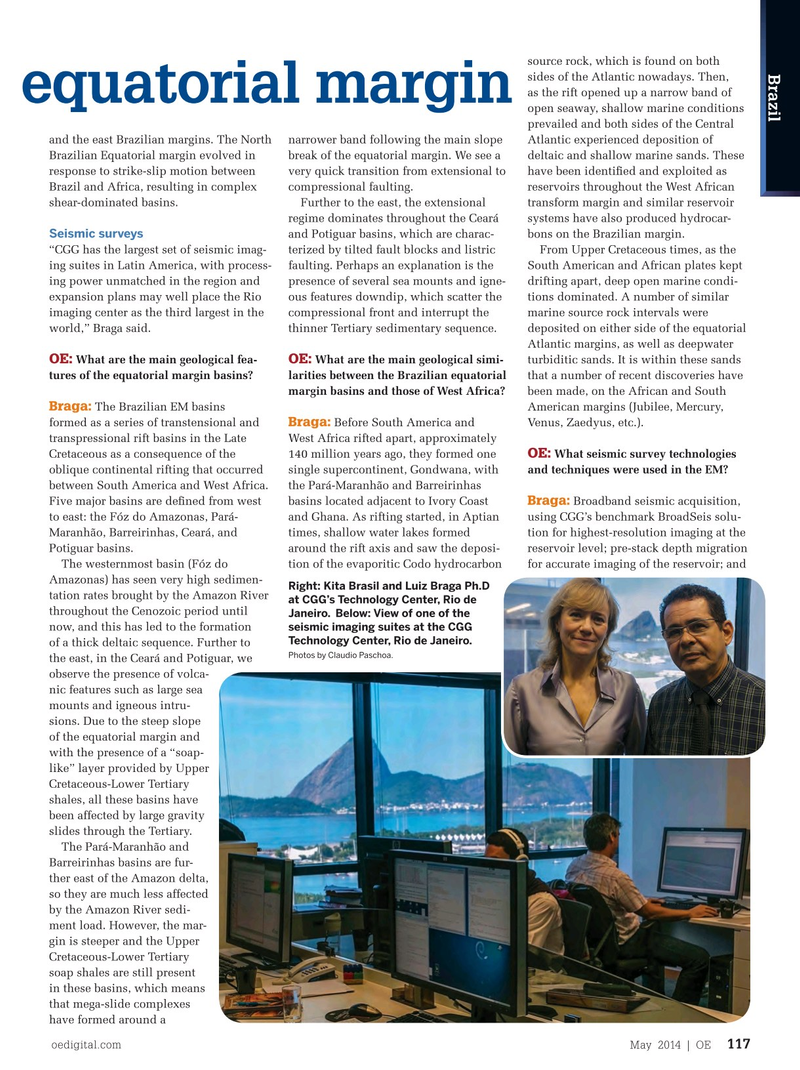
Page 115: of Offshore Engineer Magazine (May/Jun 2014)
Read this page in Pdf, Flash or Html5 edition of May/Jun 2014 Offshore Engineer Magazine
source rock, which is found on both
Brazil sides of the Atlantic nowadays. Then, as the rift opened up a narrow band of equatorial margin open seaway, shallow marine conditions prevailed and both sides of the Central and the east Brazilian margins. The North narrower band following the main slope Atlantic experienced deposition of
Brazilian Equatorial margin evolved in break of the equatorial margin. We see a deltaic and shallow marine sands. These response to strike-slip motion between very quick transition from extensional to have been identifed and exploited as
Brazil and Africa, resulting in complex compressional faulting. reservoirs throughout the West African shear-dominated basins. Further to the east, the extensional transform margin and similar reservoir regime dominates throughout the Ceará systems have also produced hydrocar-
Seismic surveys and Potiguar basins, which are charac- bons on the Brazilian margin.
“CGG has the largest set of seismic imag- terized by tilted fault blocks and listric From Upper Cretaceous times, as the ing suites in Latin America, with process- faulting. Perhaps an explanation is the South American and African plates kept ing power unmatched in the region and presence of several sea mounts and igne- drifting apart, deep open marine condi- expansion plans may well place the Rio ous features downdip, which scatter the tions dominated. A number of similar imaging center as the third largest in the compressional front and interrupt the marine source rock intervals were world,” Braga said. thinner Tertiary sedimentary sequence. deposited on either side of the equatorial
Atlantic margins, as well as deepwater What are the main geological fea- What are the main geological simi- turbiditic sands. It is within these sands
OE: OE: tures of the equatorial margin basins? larities between the Brazilian equatorial that a number of recent discoveries have margin basins and those of West Africa? been made, on the African and South The Brazilian EM basins American margins (Jubilee, Mercury,
Braga:
Braga: formed as a series of transtensional and Before South America and Venus, Zaedyus, etc.).
transpressional rift basins in the Late West Africa rifted apart, approximately
OE:
Cretaceous as a consequence of the 140 million years ago, they formed one What seismic survey technologies oblique continental rifting that occurred single supercontinent, Gondwana, with and techniques were used in the EM? between South America and West Africa. the Pará-Maranhão and Barreirinhas
Braga:
Five major basins are defned from west basins located adjacent to Ivory Coast Broadband seismic acquisition, to east: the Fóz do Amazonas, Pará- and Ghana. As rifting started, in Aptian using CGG’s benchmark BroadSeis solu-
Maranhão, Barreirinhas, Ceará, and times, shallow water lakes formed tion for highest-resolution imaging at the
Potiguar basins. around the rift axis and saw the deposi- reservoir level; pre-stack depth migration
The westernmost basin (Fóz do tion of the evaporitic Codo hydrocarbon for accurate imaging of the reservoir; and
Amazonas) has seen very high sedimen-
Right: Kita Brasil and Luiz Braga Ph.D tation rates brought by the Amazon River at CGG’s Technology Center, Rio de throughout the Cenozoic period until
Janeiro. Below: View of one of the now, and this has led to the formation seismic imaging suites at the CGG
Technology Center, Rio de Janeiro. of a thick deltaic sequence. Further to
Photos by Claudio Paschoa.
the east, in the Ceará and Potiguar, we observe the presence of volca- nic features such as large sea mounts and igneous intru- sions. Due to the steep slope of the equatorial margin and with the presence of a “soap- like” layer provided by Upper
Cretaceous-Lower Tertiary shales, all these basins have been affected by large gravity slides through the Tertiary.
The Pará-Maranhão and
Barreirinhas basins are fur- ther east of the Amazon delta, so they are much less affected by the Amazon River sedi- ment load. However, the mar- gin is steeper and the Upper
Cretaceous-Lower Tertiary soap shales are still present in these basins, which means that mega-slide complexes have formed around a oedigital.com May 2014 | OE 117 116_OE0513_Brazil1_EqMargins.indd 117 4/19/14 10:04 AM

 114
114

 116
116